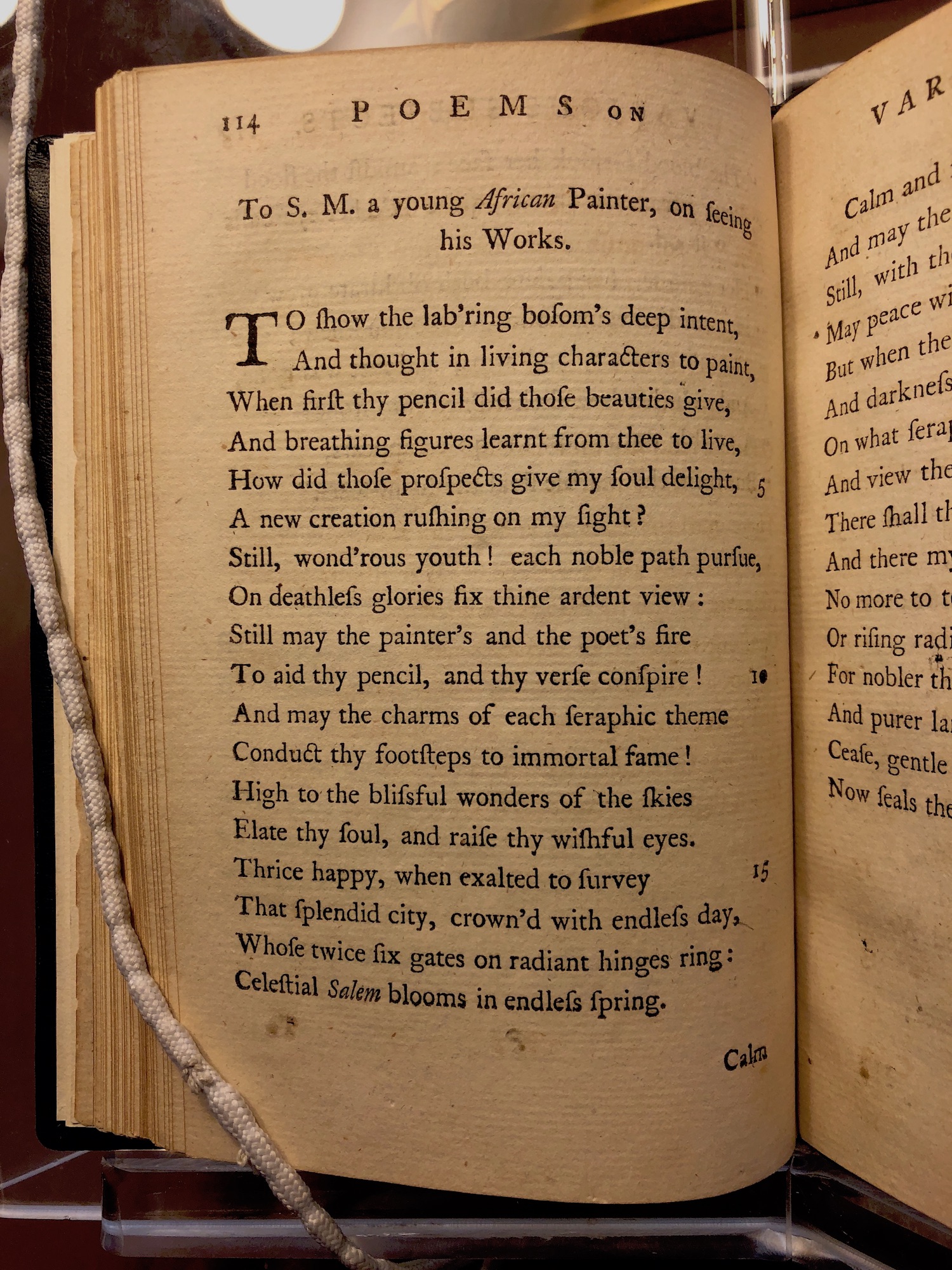"To S. M. a young African Painter, on seeing his Works"
By
Phillis Wheatley
Transcription, correction, editorial commentary, and markup by Students of Marymount University, James West, Amy Ridderhof
114
To S. M.SMSMAccording to Africana:
The Encyclopedia of the African and African American Experience, Scipio
Moorhead was an enslaved artist, principally known for his painting of Phillis
Wheatley, which became the basis for the frontispiece to her 1773 collection of
poems. The frontispiece is included in this database. While no signed paintings by
Moorhead survive, this poem by Wheatley may describe two of his works. Moorhead
was owned by the Presbyterian minister John Moorhead of Boston and was likely
tutored by Sarah Moorhead (Appiah and Gates
62). - [TH] a young African Painter, on seeing his
Works.
1TO show the lab'ring bosom's deep intent,
2And thought in living characters to paint,
3When first thy pencil did those beauties give,
4And breathing figures learnt from thee to live,
5How did those prospects give my soul delight,
6A new creation rushing on my sight?
7Still, wond'rous youth! each noble path pursue,
8On deathless glories fix thine ardent view:
9Still may the painter's and the poet's fire
10To aid thy pencil, and thy verse conspire!
11And may the charms of each seraphic theme
12Conduct thy footsteps to immortal fame!
13High to the blissful wonders of the skies
14Elate thy soul, and raise thy wishful eyes.
15Thrice happy, when exalted to survey
16That splendid citycitycityWheatley
refers to the heavenly city of "New Jerusalem," described in Revelation 21. As
many scholars have noted, Christianity offered a not uncomplicated narrative of
salvation and hope that was particularly resonant for the enslaved. She
continues this metaphor of future bliss crowning current woe throughout this
and other poems; see, for instance, lines 23-28, below. - [TH], crown'd with
endless day,
17Whose twice six gates on radiant hinges ring:
18Celestial Salem blooms in endless spring.
115
19Calm and serene thy moments glide along,
20And may the muse inspire each future song!
21Still, with the sweets of contemplation bless'd,
22May peace with balmy wings your soul invest!
23But when these shades of time are chas'd away,
24And darkness ends in everlasting day,
25On what seraphic pinions shall we move,
26And view the landscapes in the realms above?
27There shall thy tongue in heav'nly murmurs flow,
28And there my muse with heav'nly transport glow:
29No more to tell of Damon's tender sighs_DamonDamonDamon is a typical name for a male lover
in pastoral poetry, poetry that imagines romantic conflicts in bucolic or
country settings. Wheatley frequently both references and draws on classical
pastoral poetry throughout her Poems. For a deeper
reading of Wheatley's use of the pastoral, see John C. Shield's scholarly
essay, "Phillis Wheatley's Subversive Pastoral." - [TH],
30Or rising radiance of Aurora's eyesAuroraAuroraIn Greco-Roman mythology, Aurora (called Eos in the
Greek) personifies the dawn. - [TH],
31For nobler themes demand a nobler strain,
32And purer language on th' ethereal plain.
33Cease, gentle muse! the solemn gloom of night
34Now seals the fair creation from my sight.
Footnotes
_SMAccording to Africana:
The Encyclopedia of the African and African American Experience, Scipio
Moorhead was an enslaved artist, principally known for his painting of Phillis
Wheatley, which became the basis for the frontispiece to her 1773 collection of
poems. The frontispiece is included in this database. While no signed paintings by
Moorhead survive, this poem by Wheatley may describe two of his works. Moorhead
was owned by the Presbyterian minister John Moorhead of Boston and was likely
tutored by Sarah Moorhead (Appiah and Gates
62).
_cityWheatley
refers to the heavenly city of "New Jerusalem," described in Revelation 21. As
many scholars have noted, Christianity offered a not uncomplicated narrative of
salvation and hope that was particularly resonant for the enslaved. She
continues this metaphor of future bliss crowning current woe throughout this
and other poems; see, for instance, lines 23-28, below.
_DamonDamon is a typical name for a male lover
in pastoral poetry, poetry that imagines romantic conflicts in bucolic or
country settings. Wheatley frequently both references and draws on classical
pastoral poetry throughout her Poems. For a deeper
reading of Wheatley's use of the pastoral, see John C. Shield's scholarly
essay, "Phillis Wheatley's Subversive Pastoral."
_AuroraIn Greco-Roman mythology, Aurora (called Eos in the
Greek) personifies the dawn.

